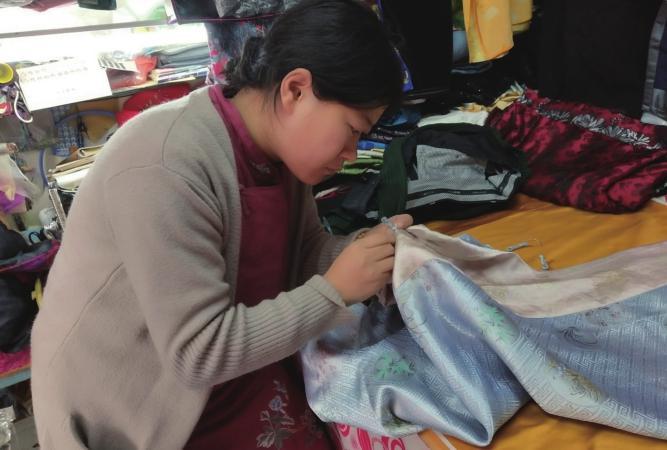Giving an Old Qipao A Second Life
2019-04-15ByJacquelineMiller
By Jacqueline Miller
I dont know exactly when my love affair with qipaos, or cheongsams, started. I just know that when I saw Zhao Wei(Vicki Zhao) and her costars wearing qipaos in Romance in the Rain TV series, which is set in Shanghai in the 1930s, I was smitten. Whereas Chinese ladies like to wear qipaos for special events, e.g. red ones for weddings, I wear them more frequently, both for parties and sometimes even in the offi ce.
I have accumulated several qipaos, some of them bought at a store in one of Beijings historical neighborhoods. The woman who works there has also patched up my canary yellow qipao with a modern paisley design—I had burnt a hole in the buttocks area while ironing it, which would have made it unwearable if she hadnt fi xed it with a tulip-like patch in similar colors to the fabric.
A Chinese friend of mine recently gave me one of her old qipaos, which almost reaches my ankles. The ice blue fabric features circles with four plants collectively known as meilanzhuju in China—an abbreviation for hardy plum blossoms that bloom in the bitter cold of winter, lush orchids that bloom in the spring, juicy bamboo in summer and fi rework-like chrysanthemums in autumn. The qipao fi ts well at the shoulders, but not at the hips—they were too wide, or conversely, the qipao was simply too tight.
Many foreigners bodies differ from that of the Chinese, which makes it hard for some foreigners to pull off the qipao look. Because I am not too short, and pretty slim, I can often buy qipaos off the rack in China, but this one was just too tight in the hip area, and of course, I didnt want my qipao to be bursting at the seams. After consulting the woman in the qipao shop, who quoted me a price, I shopped around before making an informed decision. Other tailors said it was a sartorial mission impossible widening the qipao because it required ripping up the fastening knots on the side. Another said it wouldnt look good even if a tailor was able to alter it.

Skeptics couldnt seem to understand the sentimental value I was attaching to an old qipao; why not simply buy a new one? But by having the old qipao altered by the woman I had gone to first, I would only be paying a third of what it would cost to buy a new tailormade one.
More importantly, the value in it was that my dear friend who had been a prolifi c actress in 1980s China had given it to me; it was a token of our friendship.
Even before the alterations, I thought it suited me well, and the blue matched the color of my eyes, and Im fascinated by “old”things.
I fi nally decided to have the woman in the qipao store alter it. The woman said my qipao was “Shanghai style” and made of brocade, maybe 20-30 years ago, and that they do not make those qipaos anymore. It had held pretty well throughout the years and was also hand-stitched (Today, machines mostly do the tailoring work).
The “qipao doctor” said she could add material to widen it, so I chose a light pink fabric with a “noble” floral design, which fitted well with the four seasons motif on the qipao and has a similar consistency with the original material. Being a used qipao, there were some stains which needed to be augmented with new material, and thus could be removed by cutting out the ruined material and dry-cleaning the tailored dress to remove the remaining stains.
So my old qipao was altered to my satisfaction and given a second life.
In my native United States, non-Asians are sometimes criticized on social media for wearing qipaos because of so-called cultural appropriation, but in China, people have what I consider a more reasonable and open-minded approach: If foreigners wear qipaos, it is seen as a gesture of appreciation for Chinese culture.
